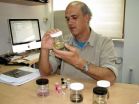Blind scottish centipede unlocks clues to the origins of creepy crawlies
2014-11-25
(Press-News.org) The arthropods are one of Earth's real success stories, with more species of arthropod than in any other animal phylum, but our knowledge of arthropod genomes has been heavily skewed towards the insects. Recent work has furnished us with the genome sequences of an arachnid and a crustacean, but the myriapods (centipedes and millipedes) have remained the one class of arthropods whose genomes are still in the dark.
An international team of scientists (over 100 from 15 countries) with Stephen Richards (Baylor College of Medicine) as senior author has now sequenced the genome of the centipede Strigamia maritima, enabling them to reconstruct many features of the genetic make-up of the ancestral arthropod that lived more than half a billion years ago. In a report publishing November 25 in the open access journal PLOS Biology, the team reveals our first glimpse of a myriapod genome and uses it to explore the genetic basis of centipede biology and of the incredible diversification of arthropods.
Myriapods probably arose from marine ancestors that invaded the land more than 400 million years ago. They have a large number of near-identical segments, each bearing one or two pairs of legs. Despite their name, centipedes never have a hundred legs (the number of pairs is always odd), though Strigamia itself gets close with 45 to 51 pairs. Although most of us are familiar with centipedes in gardens and woodland, Strigamia lives in coastal habitats, and like most centipedes is a venomous carnivore.
Over a decade ago a team from Cambridge University, headed by Professor Michael Akam, started making the long trip up to Brora on the coast of the Moray Firth in Scotland to lie on their bellies on the beach, digging under the pebbles to hunt out their favorite centipede. Strigamia is favored by scientists for the accessibility of its nests, from which embryos can be gathered for study - making the species an ideal candidate for obtaining the first genome sequence from a myriapod, and opening the door to new understandings of the developmental biology and ecology of these secretive animals.
Ariel Chipman (Hebrew University of Jerusalem) and David Ferrier (University of St. Andrews) are lead co-authors of the report. "This genome of Strigamia has proved to be particularly valuable in deducing the content of important gene families in the ancestral arthropod, this ancestor then being the starting point for the evolution of the huge diversity of arthropods that we currently see today", said David Ferrier.
"There has been a high turn-over in arthropod gene and genome organization, with lots of rearrangements and plenty of gene losses during the evolution of animals like the insects. The sorts of reconstructions that have been made possible by this new myriapod genome provide a foundation for delving more deeply into the biology of these genetic changes to see how they were linked to the diversification of the incredible range of body forms and modes of life that we now find in the arthropods."
One of the most surprising findings is that these centipedes appear to have lost the genes encoding all of the known light receptors used by animals, as well as the genes controlling circadian rhythm - the body's internal clock.
"Strigamia live underground and have no eyes, so it is not surprising that many of the genes for light receptors are missing, but they behave as if they are hiding from the light. They must have some alternative way of detecting when they are exposed," says Professor Akam. "It's curious, too, that this creature appears to have no body clock - or if it does, it must use a system very different to other animals."
Visits to Brora beach are likely to continue for years to come as scientists continue to work to unravel more of the mysteries that this new genome sequence has opened up.
INFORMATION:
ELSE PRESS RELEASES FROM THIS DATE:
2014-11-25
Centipedes, those many-legged creatures that startle us in our homes and gardens, have been genetically sequenced for the first time. In a new study in the journal PLoS Biology, an international team of over 100 scientists today reveals how this humble arthropod's DNA gave them new insight into how life developed on our planet.
Centipedes are members of the arthropods, a group with numerous species including insects, spiders and other animals. Until now, the only class of arthropods not represented by a sequenced genome was the myriapods, which include centipedes and ...
2014-11-25
Learning-related brain activity in Parkinson's patients improves as much in response to a placebo treatment as to real medication, according to a new study by researchers at the University of Colorado Boulder and Columbia University.
Past research has shown that while Parkinson's disease is a neurological reality, the brain systems involved may also be affected by a patient's expectations about treatment. The new study, published in the journal Nature Neuroscience, explains how the placebo treatment -- when patients believe they have received medication when they have ...
2014-11-25
Endangered Snake River sockeye salmon are regaining the fitness of their wild ancestors, with naturally spawned juvenile sockeye migrating to the ocean and returning as adults at a much higher rate than others released from hatcheries, according to a newly published analysis. The analysis indicates that the program to save the species has succeeded and is now shifting to rebuilding populations in the wild.
Biologists believe the increased return rate of sockeye spawned naturally by hatchery-produced parents is high enough for the species to eventually sustain itself in ...
2014-11-25
MAYWOOD, Il. - An award-winning study by a Loyola University Chicago Stritch School of Medicine researcher has documented how homeless, mentally ill women in India face a vicious cycle:
During psychotic episodes, they wander away from home, sometimes for long distances, and wind up in homeless shelters. They then are returned to their families before undergoing sufficient psychosocial rehabilitation to deal with their illness. Consequently, they suffer mental illness relapses and wind up homeless again.
"The study illustrates how there must be a balance between reintegrating ...
2014-11-25
While the turkey you eat on Thursday will bring your stomach happiness and could probably kick-start an afternoon nap, it may also save your life one day.
That's because the biological machinery needed to produce a potentially life-saving antibiotic is found in turkeys. Looks like there is one more reason to be grateful this Thanksgiving.
"Our research group is certainly thankful for turkeys," said BYU microbiologist Joel Griffitts, whose team is exploring how the turkey-born antibiotic comes to be. "The good bacteria we're studying has been keeping turkey farms healthy ...
2014-11-25
How is it that vultures can live on a diet of carrion that would at least lead to severe food-poisoning, and more likely kill most other animals? This is the key question behind a recent collaboration between a team of international researchers from Denmark's Centre for GeoGenetics and Biological Institute at the University of Copenhagen, Aarhus University, the Technical University of Denmark, Copenhagen Zoo and the Smithsonian Institution in the USA. An "acidic" answer to this question is now published in the scientific journal Nature Communications.
When vultures eat ...
2014-11-25
Who knew Blu-ray discs were so useful? Already one of the best ways to store high-definition movies and television shows because of their high-density data storage, Blu-ray discs also improve the performance of solar cells -- suggesting a second use for unwanted discs -- according to new research from Northwestern University.
An interdisciplinary research team has discovered that the pattern of information written on a Blu-ray disc -- and it doesn't matter if it's Jackie Chan's "Supercop" or the cartoon "Family Guy" -- works very well for improving light absorption across ...
2014-11-25
New York, NY, November 25, 2014 - Testosterone (T) therapy is routinely used in men with hypogonadism, a condition in which diminished function of the gonads occurs. Although there is no evidence that T therapy increases the risk of prostate cancer (PCa), there are still concerns and a paucity of long-term data. In a new study in The Journal of Urology®, investigators examined three parallel, prospective, ongoing, cumulative registry studies of over 1,000 men. Their analysis showed that long-term T therapy in hypogonadal men is safe and does not increase the risk of ...
2014-11-25
LAWRENCE -- Physicists at the University of Kansas have fabricated an innovative substance from two different atomic sheets that interlock much like Lego toy bricks. The researchers said the new material -- made of a layer of graphene and a layer of tungsten disulfide -- could be used in solar cells and flexible electronics. Their findings are published today by Nature Communications.
Hsin-Ying Chiu, assistant professor of physics and astronomy, and graduate student Matt Bellus fabricated the new material using "layer-by-layer assembly" as a versatile bottom-up nanofabrication ...
2014-11-25
The bacterium Helicobacter pylori is strongly associated with gastric ulcers and cancer. To combat the infection, researchers at University of California, San Diego School of Medicine and Jacobs School of Engineering developed LipoLLA, a therapeutic nanoparticle that contains linolenic acid, a component in vegetable oils. In mice, LipoLLA was safe and more effective against H. pylori infection than standard antibiotic treatments.
The results are published online Nov. 24 in the Proceedings of the National Academy of Sciences.
"Current H. pylori treatments are facing ...
LAST 30 PRESS RELEASES:
[Press-News.org] Blind scottish centipede unlocks clues to the origins of creepy crawlies



